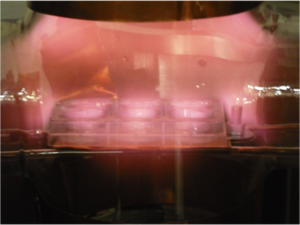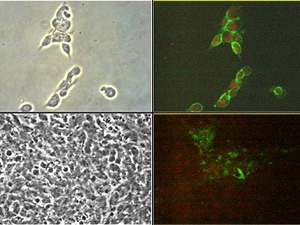Stem Cell Differentiation
The goal of this project is directing the differentiation of stem cells to produce arterial endothelial cells. Endothelial cells make up the innermost layer of blood vessels and physically interface with circulating blood. Important goals like blood vessel repair and the creation of artificial arterial grafts depend on the ready supply of this cell type. By polymerization in arc plasma, a very unique and controllable film coating can be deposited on the surface of a common cell culture plate. Mouse embryonic stem cells cultured in such coated plates have been shown to preferentially differentiate toward endothelial cells, without the aid of growth factors. Research continues in the effort to more precisely control this directed differentiation and apply the process to human stem cells. This multi-disciplinary research project helps to continue the University of Wisconsin’s tradition of first-class stem cell research.
|
Cell Culture: The left-hand column shows phase contrast images of the fixed R1 mouse ES cells cultured on a plasma-polymerized surface. The right-hand column shows staining of the PECAM or vWF markers with the Alexa 488 secondary antibody. These images are overlayed with PI staining of all cell nuclei. The first row shows groups of PECAM+ cells on the plasma-polymerized tetraglyme surface three days after plating. The second row shows groups of vWF+ cells on the plasma-polymerized tetraglyme surface seven days after plating. |

Tetraglyme Deposition in Progress: It is the processing of a six-well culturing plate in the plasma reactor. The reactants are drawn into the wells by a negatively-biased stand, resulting in the bright plasma in each well.


